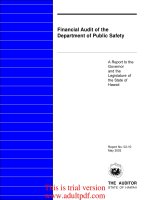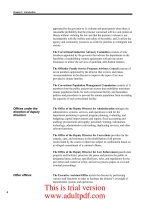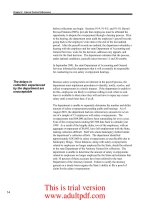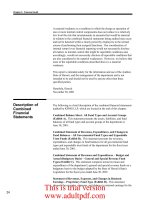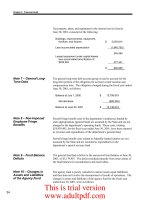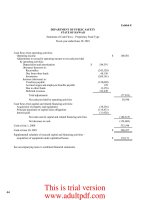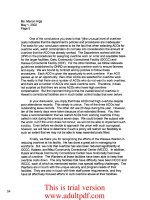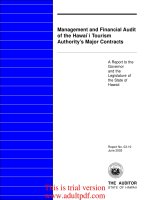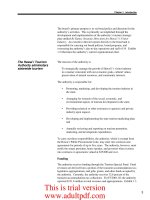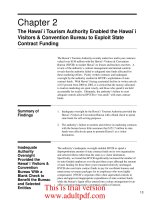Financial Audit of the Hawaii Public Employees Health Fund A Report to the Governor and the Legislature of the State of Hawaii_part3 pot
Bạn đang xem bản rút gọn của tài liệu. Xem và tải ngay bản đầy đủ của tài liệu tại đây (240.65 KB, 11 trang )
15
Chapter 2: Internal Control Deficiencies Exist
because many of the employees whose contributions created the excess
reserves would not benefit, due to their retirement, resignation, or transfer
to a union-sponsored plan.
During the 1998 legislative session, management tried but failed to have a
bill passed that would have allowed the Health Fund to provide cash
refunds to its current and former employees.
In addition, we were informed that management obtained an opinion from
a deputy attorney general in August 1998 that indicates the Health Fund
cannot provide cash refunds to its employees. However, we were not
allowed to read the opinion.
Management has been unable to resolve the disposition of excess reserves
applicable to employee contributions since July 1997, more than 18
months ago. Unless management can resolve this matter, the reserves will
continue to grow, and employees will receive unequal treatment from
employers regarding the refunding of excess reserves.
We recommend that management work more closely with the Legislature
and the Departments of Budget and Finance and the Attorney General in
resolving the issues relating to (a) the adoption of a long-term care
insurance benefit plan and (b) the disposition of excess reserves created
by employee contributions.
Recommendation
This is trial version
www.adultpdf.com
16
Chapter 2: Internal Control Deficiencies Exist
This page intentionally left blank.
This is trial version
www.adultpdf.com
17
Chapter 3: Financial Audit
Chapter 3
Financial Audit
This chapter presents the results of the financial audit of the Hawaii
Public Employees Health Fund (Health Fund) as of and for the fiscal year
ended June 30, 1998. This chapter includes the independent auditors’
report and the report on compliance and on internal control over financial
reporting based upon the audit performed in accordance with Government
Auditing Standards. It also displays financial statements together with
explanatory notes.
Because the Health Fund did not account for its financial activities in an
enterprise fund as required by generally accepted accounting principles
and because certain gain contingencies have been recorded in the financial
statements, in the opinion of Deloitte & Touche LLP, based on their audit,
the financial statements do not present fairly the financial position of the
Health Fund at June 30, 1998, and the results of its operations for the
year then ended in conformity with generally accepted accounting
principles.
Deloitte & Touche LLP considered the Health Fund’s failure to account
for its activities in the proper fund to be a reportable condition and a
material weakness in the internal control system. But, they did not note,
with respect to the items tested, any instance of noncompliance with laws
and regulations applicable to the Health Fund that are required to be
reported under Government Auditing Standards.
To the Auditor
State of Hawaii
We have audited the following financial statements of the Hawaii
Public Employees Health Fund (Health Fund):
• Combined Balance Sheet – All Fund Types and Account
Groups – June 30, 1998 (Exhibit A);
• Combined Statement of Revenues, Expenditures and
Changes in Fund Equity – General and Expendable Trust
Funds – fiscal year ended June 30, 1998 (Exhibit B);
Summary of
Findings
Independent
Auditors’ Report
This is trial version
www.adultpdf.com
18
Chapter 3: Financial Audit
• Combined Statement of Revenues and Expenditures –
Budget and Actual – General Fund – fiscal year ended
June 30, 1998 (Exhibit C);
• Statement of Changes in Assets and Liabilities – Agency
Fund – fiscal year ended June 30, 1998 (Exhibit D).
These financial statements are the responsibility of the
management of the Health Fund. Our responsibility is to express
an opinion on these financial statements based on our audit.
Except as discussed in the following two paragraphs, we
conducted our audit in accordance with generally accepted
auditing standards and the standards applicable to financial audits
contained in Government Auditing Standards issued by the
Comptroller General of the United States. Those standards
require that we plan and perform the audit to obtain reasonable
assurance about whether the financial statements are free of
material misstatement. An audit includes examining, on a test
basis, evidence supporting the amounts and disclosures in the
financial statements. An audit also includes assessing the
accounting principles used and significant estimates made by
management, as well as evaluating the overall financial statement
presentation. We believe that our audit provides a reasonable
basis for our opinion.
In accordance with the terms of our engagement, the scope of our
audit did not include the general fixed assets account group,
which reflected total assets of $387,939 as of June 30, 1998.
Management of the Health Fund declined to provide us with a
written representation letter which, among other things,
acknowledges its responsibility for the fair presentation of the
financial statements in accordance with generally accepted
accounting principles. Generally accepted auditing standards
require us to obtain such management representation letter.
As discussed in the notes to the financial statements, the financial
statements referred to above present only the activities of the
Health Fund and are not intended to present fairly the financial
position and results of operations of the State of Hawaii, in
conformity with generally accepted accounting principles.
The financial statements referred to above account for the
financial activities of the Health Fund in a governmental fund,
i.e., general fund, and in fiduciary funds, i.e., trust and agency
funds. However, in our opinion, the Health Fund is considered to
be a public entity risk pool, and thus its financial activities should
This is trial version
www.adultpdf.com
19
Chapter 3: Financial Audit
be accounted for in a proprietary fund, i.e., enterprise fund, in
order to conform with generally accepted accounting principles.
In addition, the financial statements referred to above include net
underwriting gains of $17,400,084 and interest income of
$2,096,938 that are recorded in the deposit with insurance
carriers account, with the offsetting credits being recorded as
other financing sources of $14,383,869, and beginning fund
balance of $5,113,153. In our opinion, such amounts are
considered to be gain contingencies, since they can be offset by
underwriting losses incurred in the fiscal year ending June 30,
1999, the last year of the contract period with the insurance
carriers. Accordingly, such amounts should not be recorded in
the financial statements, in order for such financial statements to
be in conformity with generally accepted accounting principles.
Governmental Accounting Standards Board Technical
Bulletin 98-1, Disclosures about Year 2000 Issues, requires
disclosure of certain matters regarding the year 2000 issue in
order for financial statements to be prepared in accordance with
generally accepted accounting principles. Such required
disclosures include:
• Any significant amount of resources committed to make
computer systems and other electronic equipment year
2000-compliant;
• A general description of the year 2000 issue, including a
description of the stages of work in process or completed
as of the end of the reporting period to make computer
systems and other electronic equipment critical to
conducting operations year 2000-compliant; and
• The additional stages of work necessary for making the
computer systems and other electronic equipment year
2000-compliant.
The Health Fund has omitted such disclosures. We do not
provide assurance that the Health Fund is or will be year 2000
ready, that the Health Fund’s year 2000 remediation efforts will
be successful in whole or in part, or that parties with which the
Health Fund does business will be year 2000 ready.
In our opinion, because of the effects of the matters discussed in
the three preceding paragraphs, the financial statements referred
to above do not present fairly, in conformity with generally
This is trial version
www.adultpdf.com
20
Chapter 3: Financial Audit
accepted accounting principles, the financial position of the
Health Fund as of June 30, 1998, or the results of its operations
for the year then ended.
In accordance with Government Auditing Standards, we have
also issued our report dated December 24, 1998, on our
consideration of the Health Fund’s internal control over financial
reporting and our tests of its compliance with certain provisions
of laws, regulations, contracts, and grants.
/s/ Deloitte & Touche LLP
Honolulu, Hawaii
December 24, 1998
To the Auditor
State of Hawaii
We have audited the financial statements of the Hawaii Public
Employees Health Fund (Health Fund) as of and for the year
ended June 30, 1998, and have issued our report thereon dated
December 24, 1998, which included an adverse opinion resulting
from the Health Fund: (1) not accounting for financial activities
in a proprietary fund, (2) recording gain contingencies, and (3)
omitting the year 2000 disclosures that are required by
Government Auditing Standards Board Technical Bulletin 98-1,
Disclosures about Year 2000 Issues. We conducted our audit in
accordance with generally accepted auditing standards and the
standards applicable to financial audits contained in Government
Auditing Standards, issued by the Comptroller General of the
United States, except that management of the Health Fund
declined to provide us with a written representation letter, which
is required under generally accepted auditing standards, and that
the scope of our audit did not include the general fixed assets
account group.
Compliance
As part of obtaining reasonable assurance about whether the
Health Fund’s financial statements are free of material
misstatement, we performed tests of its compliance with certain
provisions of laws, regulations, contracts, and grants,
noncompliance with which could have a direct and material effect
on the determination of financial statement amounts. However,
Independent
Auditors’ Report
on Compliance and
on Internal Control
over Financial
Reporting Based
upon the Audit
Performed in
Accordance with
Government
Auditing Standards
This is trial version
www.adultpdf.com
21
Chapter 3: Financial Audit
providing an opinion on compliance with those provisions was not
an objective of our audit and accordingly, we do not express such
an opinion. The results of our tests disclosed no instances of
noncompliance that are required to be reported under Government
Auditing Standards.
Internal Control over Financial Reporting
In planning and performing our audit, we considered the Health
Fund’s internal control over financial reporting in order to
determine our auditing procedures for the purpose of expressing
our opinion on the financial statements and not to provide
assurance on the internal control over financial reporting.
However, we noted a certain matter involving the internal control
over financial reporting and its operation that we consider to be a
reportable condition. Reportable conditions involve matters
coming to our attention relating to significant deficiencies in the
design or operation of the internal control over financial reporting
that, in our judgment, could adversely affect the Health Fund’s
ability to record, process, summarize, and report financial data
consistent with the assertions of management in the financial
statements. The reportable condition is as follows:
The Health Fund is incorrectly reporting its financial activities in
governmental and fiduciary funds rather than in an enterprise
fund as required by generally accepted accounting principles.
This results from the accounting staff’s inability to keep current
on relevant accounting standards.
A material weakness is a condition in which the design or
operation of one or more of the internal control components does
not reduce to a relatively low level the risk that misstatements
caused by error or fraud in amounts that would be material in
relation to the financial statements being audited may occur and
not be detected within a timely period by employees in the normal
course of performing their assigned functions. Our consideration
of the internal control over financial reporting would not
necessarily disclose all matters in the internal control that might
be reportable conditions and, accordingly, would not necessarily
disclose all reportable conditions that are also considered to be
material weaknesses. However, we believe that the reportable
condition described above is a material weakness.
This report is intended solely for the information and use of the
Auditor, State of Hawaii, the management and directors of the
This is trial version
www.adultpdf.com
22
Chapter 3: Financial Audit
Health Fund, the Governor, and the Legislature of the State of
Hawaii and is not intended to be and should not be used by
anyone other than these specified parties.
/s/ Deloitte & Touche LLP
Honolulu, Hawaii
December 24, 1998
The following is a brief description of the financial statements which are
attached to the end of this chapter.
Combined Balance Sheet - All Fund Types and Account Groups
(Exhibit A). This statement presents assets, liabilities and fund equity of
all fund types and account groups used by the Health Fund on an
aggregate basis at June 30, 1998.
Combined Statement of Revenues, Expenditures and Changes in Fund
Equity - General and Expendable Trust Funds (Exhibit B). This
statement presents the revenues, expenditures and changes in fund equity
for governmental and fiduciary fund types used by the Health Fund on an
aggregate basis for the year ended June 30, 1998. Revenues include State
appropriations mandated by various appropriation acts of the State
Legislature.
Combined Statement of Revenues and Expenditures - Budget and
Actual (Budgetary Basis) - General Fund (Exhibit C). This statement
summarizes revenues and expenditures by source and type on the
budgetary basis for the Health Fund for the year ended June 30, 1998, and
compares such amounts to the budget as adopted by the State Legislature.
Statement of Changes in Assets and Liabilities - Agency Fund
(Exhibit D). This statement presents the changes in assets and liabilities
of the Agency Fund for the Health Fund for the year ended June 30, 1998.
Explanatory notes, which are pertinent to an understanding of the
financial statements and financial condition of the funds included in the
scope of the audit, are discussed in this section.
Descriptions of
Financial
Statements
Notes to the
Combined Financial
Statements
This is trial version
www.adultpdf.com
23
Chapter 3: Financial Audit
The Hawaii Public Employees Health Fund (Health Fund), which is
administered by a nine-member Board of Trustees appointed by the
Governor, was established under Chapter 87 of the Hawaii Revised
Statutes (HRS) to provide medical, dental, prescription drug, vision care,
and life insurance benefits for the State of Hawaii’s (State) and the
counties’ active and retired employees and their dependents.
The Board of Trustees of the Health Fund (Board) determines the scope
of the various benefit plans and contracts with insurance carriers to
provide health and group life insurance benefit coverages.
Summary information on the Health Fund’s plans is described below:
Benefit plans - The medical plans include a statewide service benefit
plan, a statewide health maintenance organization (HMO) plan, and a
federally-qualified HMO plan. Other benefit plans (dental,
prescription drug, vision care and group life insurance) are offered on
a statewide basis.
Payment of contributions - The employers’ share of benefit plan
contributions for collectively bargained employees are negotiated by
the State and counties with the exclusive representative of each
employee bargaining unit. Employer contributions for all other
employees not covered by collective bargaining contracts and for
employees who retire after June 30, 1984, with less than ten years of
service, are prescribed by the HRS. Any remaining premium balance
is paid by employees through payroll deductions or Premium
Conversion Plan reductions.
State and county contributions also include the employee’s share for
retired employees and Medicare reimbursements made by the Health
Fund to eligible retired employees and their spouses for Medicare Part
B insurance premiums withheld from their social security benefits.
As of June 30, 1998, the Health Fund provided insurance coverage to
approximately 145,000 individuals: 59,000 active employees; 29,000
retirees; 25,000 spouses; and 32,000 dependents under age 19.
Reporting entity
The Health Fund is a division of the Department of Budget and Finance in
the executive branch of the State. The Health Fund’s combined financial
statements reflect only its portion of the fund type categories. The State
Comptroller maintains the central accounts for all state funds and
publishes annual financial statements for the State which includes the
Health Fund’s financial activities.
Note 2 - Summary of
significant accounting
policies
Note 1 - Financial
Reporting Entity
This is trial version
www.adultpdf.com
24
Chapter 3: Financial Audit
Basis of presentation
The accounts of the Health Fund are organized on the basis of funds and
account groups, each of which is considered a separate accounting entity.
The operations of each fund are accounted for with a separate set of self-
balancing accounts that comprise its assets, liabilities, fund equity,
revenues and expenditures. Governmental resources are allocated to and
accounted for in individual funds based upon the purposes for which they
are to be spent and the means by which spending activities are controlled.
Amounts in the “Total (Memorandum Only)” columns in the combined
financial statements represent summations of the financial statement line
items of the fund types and account groups included in those statements,
and are presented only for analytical purposes. Those summations may
include fund types and account groups that use different bases of
accounting. Consequently, amounts shown in the “Total (Memorandum
Only)” columns are not comparable to a consolidation and do not
represent the total resources available or total revenues and expenditures
of the Health Fund.
For financial reporting purposes, the Health Fund includes all funds and
account groups that are controlled by or dependent on the Health Fund’s
administrative head. Control by or dependence on the Health Fund was
determined on the basis of statutory authority and moneys flowing
through the Health Fund to each fund or account.
The Health Fund uses the following fund types and account groups:
Governmental fund types
General Fund: The general fund is the general operating fund of the
Health Fund. It is used to account for all financial activities except those
required to be accounted for in another fund. The annual operating
budget as authorized by the State Legislature provides the basic
framework within which the resources and obligations of the general fund
are accounted.
Fiduciary fund types
Trust and Agency Funds: Trust and agency funds are used to account for
assets held by the Health Fund in a trustee or agency capacity. These
include expendable trust funds which account for cash collected and
expended by the Health Fund as trustee and agency funds which account
for the receipts and disbursements of various amounts collected by the
Health Fund in a custodial capacity.
This is trial version
www.adultpdf.com
25
Chapter 3: Financial Audit
Account groups
General Fixed Assets Account Group: General fixed assets acquired for
use by the Health Fund in the conduct of its general governmental
operations are accounted for in the general fixed assets account group at
cost or estimated fair market value at date of donation. Accumulated
depreciation is not recorded in the general fixed assets account group.
General Long-Term Debt Account Group: The obligation for accrued
vested vacations is recorded in the general long-term debt account group.
Basis of accounting
The accounting and financial reporting treatment applied to a fund is
determined by its measurement focus. All governmental funds and
expendable trust funds are accounted for using a current financial
resources measurement focus. With this measurement focus, only current
assets and current liabilities are generally included on the combined
balance sheet. Operating statements of these funds present increases (i.e.,
revenues and other financing sources) and decreases (i.e., expenditures
and other financing uses) in net current assets.
The Health Fund uses the modified accrual basis of accounting for the
general, expendable trust, and agency funds. Under the modified accrual
basis of accounting, revenues and related current assets are recognized in
the accounting period when they become both measurable and available to
finance operations of the fiscal year or liquidate liabilities existing at
fiscal year-end. Measurable means that the amount of the transaction can
be determined. Available means that the amount is collected in the current
fiscal year or soon enough after year end to liquidate liabilities existing at
the end of the fiscal year. Revenues susceptible to accrual include funds
appropriated by the State Legislature and allotted by the Governor.
Use of estimates
The preparation of combined financial statements in conformity with
generally accepted accounting principles requires management to make
estimates and assumptions that affect the reported amounts of assets and
liabilities and disclosure of contingent assets and liabilities at the date of
the combined financial statements, and the reported amounts of revenues
and expenses during the reporting period. Actual results could differ from
those estimates.
Cash and short-term investments
Cash and short-term investments include all demand deposits, time
certificates of deposit and repurchase agreements purchased with an
original maturity of three months or less.
This is trial version
www.adultpdf.com
